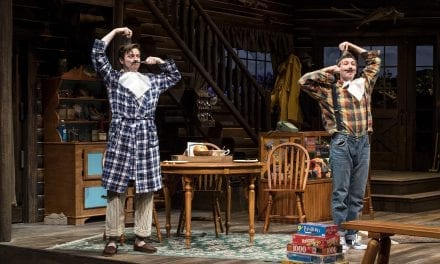 OREM — Walking into UVU’s production of A Doll’s House was a pleasant surprise. I knew that Eric Samuelsen had done the translation, but I didn’t realize that he had updated the play and set it in 1950s America until I walked into the theatre space.
OREM — Walking into UVU’s production of A Doll’s House was a pleasant surprise. I knew that Eric Samuelsen had done the translation, but I didn’t realize that he had updated the play and set it in 1950s America until I walked into the theatre space.
The greeting of a 1950s living room—the set is stunning—was a welcome surprise (A Doll’s House was originally written and set in Norway in the 1880s). As far as I could tell the translation faithfully follows Ibsen’s original text, but the language is updated, with some slight changes in locations and monetary systems to make it fit the setting. This new translation works exceptionally well; the themes are seamlessly translated to this time and place.
Unfortunately, I feel the production does not live up to the brilliance of the translation. While the set and other visual aspects of the play all serve to enhance the story, the director’s concept does not. For the majority of the play, I felt I was watching a failed attempt to make this 19th century tragedy into a 20th century sitcom. (James Arrington’s director’s note mentions this production being influenced by sitcoms and soap operas.) This sitcom style is complete with physical comedy routines and crazy antics typical of sitcoms from the 1950s, and many times I expected a wacky sound cue to punctuate a punchline that isn’t a punchline, in the typical sense of the word. It seemed to me like the Nora in this production had more in common with Lucille Ball than Henrik Ibsen—as if they wanted us to look at Nora and think, “Uh oh, Nora, how are you going to get yourself out of this pickle?” when instead we should be feeling the growing gravity of Nora’s perilous situation. The thing for me that really makes Nora’s character believable in the text is that she puts on a show for her husband—he believes her to be the picture of feminine fragility that must rest on his strong male arm for support; however, she lets this facade go, to a certain extent, with the other characters. She may still be naive, but she is not as stupid as she pretends to be for Torvald. But in this production her facade is ever present, ever false, ever giggly.
 The problem with this approach to this text, is that A Doll House is, in my mind, a tragedy, and in order for a tragedy to work you must be able to emotionally engage with the characters—we have to see them as real people who are not too dissimilar from ourselves. The hope is, then, that when we see the flaws that bring about the characters’ downfall, we can recognize our own faults and be able to change ourselves before we find ourselves succumbing to the same terrible fate as the players before us. In this sitcom style, the acting is so over-the-top and unrelenting that we don’t have a chance to empathize with the characters.
The problem with this approach to this text, is that A Doll House is, in my mind, a tragedy, and in order for a tragedy to work you must be able to emotionally engage with the characters—we have to see them as real people who are not too dissimilar from ourselves. The hope is, then, that when we see the flaws that bring about the characters’ downfall, we can recognize our own faults and be able to change ourselves before we find ourselves succumbing to the same terrible fate as the players before us. In this sitcom style, the acting is so over-the-top and unrelenting that we don’t have a chance to empathize with the characters.
Relief does come, however, in the final scene, as Nora truly confronts for the first time her husband and the masquerade that has been her life. The walls break down and we are able to see what these actors really have up their sleeves. The final scene between Torvald (Jason Sullivan) and Nora (Penny Pendleton) is impressive. I wish that I had not been as emotionally checked out, so that I could have more fully enjoyed their performances in this scene—it would’ve been a joy to watch if it hadn’t been so depressing. I only wish the entire play had been as grounded.
There are a few small things I’d like to mention, mostly for the actors and production staff. The set and its dressing were just phenomenal! Especially the pictures of birds in cages—nice touch. The last few seconds of the play were bizarre and jarring. The blocking often seemed erratic and forced; it’s nice for actors to use their space, and it was a lovely space for them to use, but you don’t have to use all of your space all of the time. I loved—just truly enjoyed—the Torvald-Knitting Moment.
To sum it all up, I think this is a really exciting new translation (and semi-adaptation) by Samuelson. A lot about the concept for this production makes sense to me cerebrally—these people are putting on elaborate shows for one another, and refuse to be sincere until the truth comes out and they are forced to. Unfortunately, the concept didn’t work for me in the actual execution—it was often distracting and frustrating. Perhaps that’s the trouble with trying to clothe a tragedy in the dress of a sitcom.
A Doll’s House plays through April 10th (M/Th/F/Sa). Performances take place at 7:30 PM in the Noorda Theatre on the campus of Utah Valley University. Tickets are $7-11 and can be purchase online at UVU.edu/theatre.




